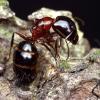- Formiculture.com
- Forums
- Gallery
- Members
- Member Map
- Chat

Tooting my horn.
Started By
Nylanderiavividula
, Feb 23 2019 6:56 AM
5 replies to this topic
#1
 Offline
-
Posted February 23 2019 - 6:56 AM
Offline
-
Posted February 23 2019 - 6:56 AM
Anyone else get a euphoric kick when they wrestle down a tough identification? Here in Georgia we have fifteen listed native Pheidole species. I recently marauded a wild colony (got the queen, ~30 workers, and varying brood stages) and set about IDing them. It didn’t take long to get it down to the crassicornis type (widened antennal scape at point of insertion)...and I was 90% positive that they were indeed P. crassicornis...but there was P. tetra and P. diversipilosa to rule out, and 90% certainty was NOT sitting well with me! So after poring over side-by-side pictures on numerous websites and crosschecking ranges and looking under my cheap little Carson microscope at some specimens...I can now say I have it whipped! Pheidole crassicornis it is thanks to the major works’ general glabrous exoskeleton!! When I finally get around to posting pictures on here, I will just go that route instead of taking so much time to knitpick an ID, as I imagine there are many of you on here far more adept than me at this line of WORK!
Camponotus castaneus
Camponotus chromaiodes (Pretty sure...)
Brachymyrmex patagonicus
Aphaenogaster sp. (I’ll be working on this species ID, soon)
Pheidole crassicornis
Camponotus chromaiodes (Pretty sure...)
Brachymyrmex patagonicus
Aphaenogaster sp. (I’ll be working on this species ID, soon)
Pheidole crassicornis
#3
 Offline
-
Posted February 23 2019 - 12:05 PM
Offline
-
Posted February 23 2019 - 12:05 PM
Sounds like Dorymyrmex bicolor to me honestly
#4
 Offline
-
Posted February 23 2019 - 12:16 PM
Offline
-
Posted February 23 2019 - 12:16 PM
Yeah? None of y'all can top my recent Formicidae sp. identification.
Spoiler
#5
 Offline
-
Posted February 23 2019 - 2:07 PM
Offline
-
Posted February 23 2019 - 2:07 PM
T.C. and Jadeninja, you fella's are cruel! Hahaha. I'm 99.9% positive of the ID and am unshakeable in the belief in myself as far as this particular ID goes. ;-P I used a combination of actual specimens (of Pheidole crassicornis) under the microscope and comparisons on antmaps.org (for habitat ranges), antweb.org, antwiki, and an excellent guide for southeastern US species, https://mississippie...tml...alongsideother images from various sites found on google. What did you find, Martialis?
- Jadeninja9 likes this
Camponotus castaneus
Camponotus chromaiodes (Pretty sure...)
Brachymyrmex patagonicus
Aphaenogaster sp. (I’ll be working on this species ID, soon)
Pheidole crassicornis
Camponotus chromaiodes (Pretty sure...)
Brachymyrmex patagonicus
Aphaenogaster sp. (I’ll be working on this species ID, soon)
Pheidole crassicornis
#6
 Offline
-
Posted February 23 2019 - 2:46 PM
Offline
-
Posted February 23 2019 - 2:46 PM
Haha nice man
0 user(s) are reading this topic
0 members, 0 guests, 0 anonymous users


















